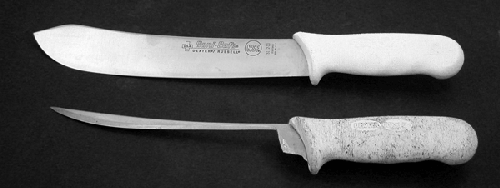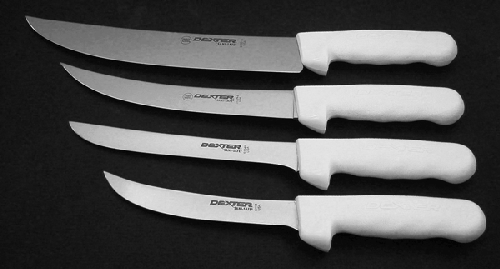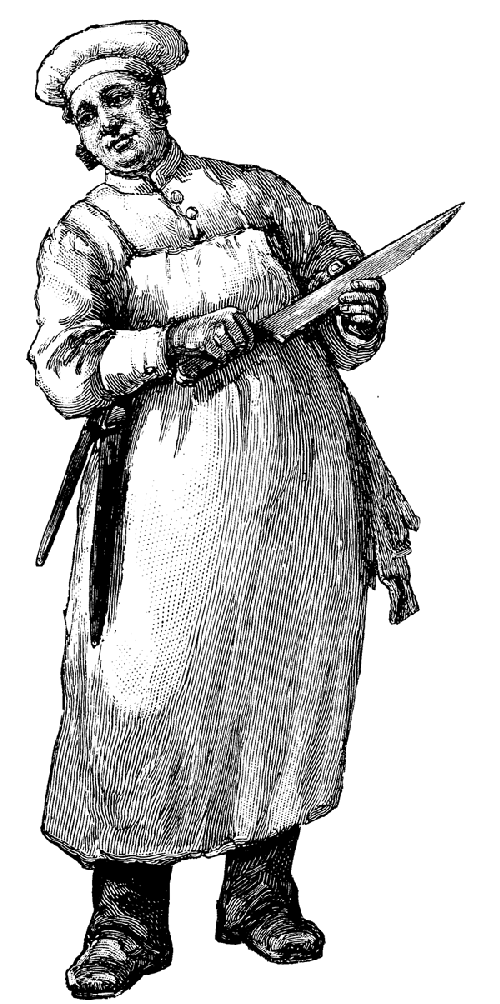Buck Raper is the manager of manufacturing and engineering for
Dexter-Russell, the largest and oldest cutlery manufacturer in the United States.
Above, Buck holds a knife next to an edge sharpness and edge life test apparatus in
their metallurgy lab.
How did you come to work at
Dexter-Russell?
In a former life, I was working on a doctorate in synthetic organic
chemistry.
Wow. What happened?
I got drafted to Vietnam.
And then you came back...
I came back and there weren’t many job opportunities for PhD chemists, and I was
still looking at two more years in school, and I had a family to support. So I went
and got an MBA and got twice the starting salary I would have gotten as a PhD. My
family had always been in the cutlery business, my grandfather, and my father, and all
I ever heard was knife talk. When I was a Baby Buck, my father would take me into the
pocket-knife factory on Saturday mornings and hand me off to a foreman so he could get
some work done, and I’d make knives with a foreman.
Did the background in chemistry, combined with your
family’s history in knife making, complement each other?
To some degree...but it was more of the scientific method and analytical
techniques that you learn in a hard science, applying them to manufacturing. I looked
at it from a different standpoint than a history major MBA would, or an English major
MBA would. Coming from a real science, you take a different approach, an engineering
approach.
Can you give me an example?
Much of the heat treating, the grinding, and the choice of steels was done almost
by folklore. It’s always been done that way and nobody remembers why. Now when we’re
trying to choose a steel for a particular application, we do some testing, make some
blades, and try them out to see what the results are. We have a control sample and
record data. That’s the type of change that I made. Dexter-Russell is 192 years old,
and we still have machinery and tooling that we were using at the turn of the century,
from 1900. Those techniques still work and they’re still very good, but nobody really
knew why we were doing things the way we were doing them.
What surprised you when you were testing the
folklore?
We’re number one in professional oyster knives, and there’s the chronic problem
with the tips of oyster knives breaking off. We had a heat-treatment process that we
thought was making the steel hard enough to not break. The theory was if the blade is
breaking, make it harder, and then the tip won’t break off. The reality was what we
needed to do was to make tougher steel. So we changed our heat treatment process to
create a tougher, softer steel.
What does it means for a steel to be tough versus
hard?
It’s a trade-off to hold an edge. The harder the steel is, the better it will hold
an edge. But you also want to have some flexibility. If you need a flexible bone or
fillet knife, a harder steel is more brittle; it would fracture. So you have to trade
off the hardness for the toughness that allows you some flexibility. The toughness
also gives you wearability, resistance to abrasion. One way an edge fails is that you
literally wear away the grains of steel, and to resist that, you’re looking for a
tough steel.
When you heat-treat steel, you martenize it to the temperature that’s going to
give you the maximum hardness. But if you underheat it, if you undercook it a little
bit, it comes out tougher. If you overcook it, it’s also tough, but then it corrodes.
In our case, when we’re talking heat-treatable stainless 400 series steel, the optimum
temperature is 1934°F / 1057°C. If you heat it to 1950°F / 1066°C,
you get the same hardness that you would if you heat it to 1920°F / 1049°C, but one is
tougher, and the other will corrode.
Steel is formed of grains. If you were to snap a knife blade in half, and look at
it with the naked eye, the texture would look like a fine cement inside the knife.
What you’re seeing is groups of grains. Steel exists in 9 or 10 different phases.
Depending on how it’s been processed, temperature-wise, it has a mixture of these
various phases, and that determines the toughness of the steel. I use the analogy of
baking a cake when I’m explaining heat treatment. You have raw dough and expose it to
heat. There’s a chemical change and a phase change, and you go from slurry to a porous
solid once it’s baked.
With steel, once it is heated to a critical temperature, cooling—called
quenching—is also critical. You’ve probably seen old movies
where the blacksmith is pounding away, when he gets the iron hot, he plunges it into
the water and there’s a hiss of steam. The reason for that is the rapid cooling. In
the case of stainless steel, you have to get it below 1350°F / 732°C in less than
three minutes in order to maintain the phase that you want. If you cool it slower, you
get a different mixture of phases in the steel. So it’s not just in bringing it up to
temperature, the cooling curve is key.
Steel is also determined by the alloy. There’re two or three dozen different types
of stainless cutlery steels, and stainless cutlery steels are just a very small subset
of alloyed steels. Alloyed steels are a subset of carbon steels. And all the
heat-treatment processes are determined by which alloy you’re working with.
Are there other types of steels that you would want to use
for particular purposes for knife making?
We want to use a stainless steel, although carbon steel makes wonderful knives.
Everybody likes their old carbon steel knives, but nowadays, with the National
Sanitation Foundation and other regulatory bodies, you can’t use carbon steel knives
in most restaurants. We choose stainless, which has chromium in it; the chromium makes
it stainless. You also have to have carbon in the steel so that you can harden it. You
add more carbon if you want to create a harder blade, and more chromium if you need to
get more corrosion resistance. When you heat-treat it, you want to come out with a
very fine texture, and things like molybdenum, vanadium, tungsten, and cobalt help you
get a fine grain. Tungsten and cobalt help make the steel tougher.
What’s the rationale prohibiting carbon knives in
restaurants?
They rust, and rust is iron oxide. It’s dirty, and where the blade has rusted,
there are pits that will retain grease. The grease will breed bacteria. It’s usually
controlled by city or state or county ordinance.
Carbon steel versus stainless steel. Which is
better?
That was a classic question that I wondered about for 30 years. I finally had a
seminar with a metallurgist from a French steel mill, and he developed a machine to
test the sharpness of edges and the life of edges. The answer is that you can get a
carbon steel edge about 5% sharper while a stainless steel edge will last about 5%
longer. With stainless steel being tougher, it is harder to create the edge, so
stainless steel often gets a bad reputation because people can’t sharpen it correctly.
It is possible to get carbon steel 5% sharper, but you would never perceive that using
a knife. You need the scientific apparatus to bring out that difference. The practical
difference is it’s very easy to bring up an edge on carbon steel, so most people’s
carbon steel knives are sharper because they’re easier to resharpen. A carbon steel
knife responds very easily to a butcher’s steel; you have to work a little bit more
with a stainless steel knife.
I’m going to ask the question that’ll probably lead to the
gates of Hell: how do I sharpen a knife correctly?
There are lots of ways to do it. Probably the best general-purpose way and what I
recommend to people is to use a diamond sharpening steel. The traditional serrated
butcher’s steel is a ½″ or ⅝″ rod with ridges running longitudinally. Those are now
being replaced by rods that are plated with diamond. The diamond rod brings up an edge
very quickly, because it’s hard enough to remove metal, creating a new edge.
An edge is actually a whole bunch of little burrs, sort of like hacksaw teeth that
are standing up, perpendicular to the back of the blade. When you cut, those little
burrs (here we call them feathers) roll over. The first thing
that happens when you swipe with a butcher’s steel is you stand those feathers up, and
you have a real good edge. After a time, they bend back and forth. They work-harden
and break off, like breaking a wire by twisting it until it work-hardens and snaps.
Then you have to create a new edge, new burrs, and the grit on a diamond steel is
perfect for that. That’s what the long serrations do on your regular butcher’s steel,
but it’s a lot easier to do with a diamond steel.
When
you run a knife edge along a steel, you stand up the burrs, and you start thinning
down the edge. I can do it with the back of a porcelain plate, or I can rub a knife on
a brick wall and bring up the edge, but a diamond steel is best.
I’ve made a lot of trips to China, and they have very primitive kitchens as far as
equipment, tools, and utensils go. They make do with the one basic knife. People call
it a cleaver, but it’s not really a cleaver. It’s a slicer and a spatula and a scraper
and everything else, but with that one knife, they stop and squat on the floor and
bring the edge back on a brick that’s in the floor. They keep those knives very, very
sharp. I learned in Chinese cooking how nicely things are sliced up counts as much as
the taste, the presentation, and the freshness of ingredients. All of that can be
ruined if you have cut raggedy chunks.
I would recommend either a diamond butcher steel or a whet stone. But a whet stone
takes more skill, more training to use. I would stay away from electric
sharpeners.
At some point the burrs snap off, and I presume that’s the
point at which one needs to actually grind down the edge of the knife to form a new
edge?
With a diamond steel, you’re doing grinding at the same time you’re straightening
up the edge. A traditional butcher’s steel isn’t hard enough to remove metal. The deal
with using a butcher’s steel is your steel has to be harder than the metal of the
blade you’re sharpening. Otherwise, you get nowhere, like using a common file to
smooth or shape metal. Your file won’t cut the metal if the file isn’t harder than the
metal it’s cutting. If you let your knife get very dull, bringing the edge back is a
real bear. If you give it a few strokes on a butcher’s steel every other day, or once
a week, or every time you go to put the knife in the drawer, then the knife is always
ready.
At what point is a knife effectively used up? [Buck shares
with me the photo shown below.] I cannot believe how much the bottom knife has been
sharpened away compared to the new knife on top. What’s the story with this actual
knife?

Whoever was resharpening that knife was very, very good. It came back to our
customer service people for replacement from a mom-and-pop butcher shop. I train our
sales force, and one of the questions they ask is how long is a knife useful. I show
them this. That’s pushing the ridiculous. I would think that that knife had seen about
five or six years of service.
We usually find in a restaurant that a knife is good for six to nine months. With
professional cutlery, and in particular with packing houses, they’ll need a wide blade
for breaking down a side of beef. They need a large curved knife, which we call a
cimeter steak knife. When it starts out life, it’s about 2 1/2″
wide, and when it gets down to about 1″ or 1 1/4″ wide, it’s no longer suitable for
breaking down the big sides of beef. So then they use it for the smaller cuts, and
call it a breaking knife. When they wear it down to about under
an inch, they use it as a boning knife.
So these knives actually go to a series of different
lives? As they get smaller from sharpening, they get repurposed and
reused?
They get narrower, and they get shorter. People find different applications for
them. The poultry industry still does that. What I’m talking about is mostly pre-WWII.
After WWII, people started coming to us and saying, “Hey, can’t you make this shape
from scratch?” So we started to create the same shape as the worn-out knife. You
wouldn’t have to wear out a giant cimeter; you could just buy a breaking knife off the
shelf. A lot of our traditional knife shapes have evolved from large blades that were
worn down and used for different applications, and then we started making a blade with
that shape.

What advice would you give somebody new to the
kitchen?
If I were being a smartass, I would tell you don’t run with a knife. Keep your
knives out of the dishwasher. Wipe them clean with a damp rag. When you put them in
the dishwasher, they bang together and you nick up your edges. If you do put them in
the dishwasher, make sure you pull them right out of the basket and dry them off. Keep
up with your sharpening; don’t let your knife get dull. Maintain the edge every time
you use it or every other time you use it. Give it one or two strokes on a steel and
sharpening will never be a chore, and you will always have a sharp knife.
Keeping your knives sharp is the kitchen equivalent of
backing up your files: it’s something you should do more often than you think. A
sharper knife is safer and easier to use:
Sharp knives require less pressure for making cuts so there’s less force
involved—meaning you’re less likely to slip and cut yourself.
Sharp knives cut cleaner; there is less “tear” through whatever you’re
cutting.
Sharp knives keep your arm from getting tired because you don’t have to muscle
through things. Of course, you’d probably need to be slicing and dicing for many
hours to notice.
Keeping your knives in good working order involves both keeping the blade “true”
(in alignment) and grinding down the blade to reshape the edge if the trued shape is
lost. To keep your knives true, use a sharpening steel (those steel rods ubiquitous in
celebrity chef photos) as part of your cleanup and wash routine at the end of a
cooking session. By running the knife against the sharpening steel, you push any
portion of the edge that is out of alignment (“burrs”) back into alignment.
(Never try to true a serrated knife, such as a bread knife—the
sharpening steel won’t fit against the serrated edge.) Look for a diamond-coated
sharpening steel; the diamond coating is harder than the steel, so it can not only
realign the burrs but also create a new edge, keeping the knife truly sharp and
actually removing the need to reshape the edge.
More serious sharpening involves grinding down the blade to form a new edge and
can be done against any hard surface: a sharpening stone, a grinding wheel, even a
brick! (See the interview with Buck Raper on the preceding pages for details.) If it
comes to that, I find it easier to have my knives professionally sharpened. Grinding
down the edge isn’t a great thing, though, because creating the new edge removes
material. Knives used in restaurants can be “sharpened through” in under a year—that
is, sharpened down to a point where the new edge on the knife becomes too thick to
hold a sharp edge for long.
